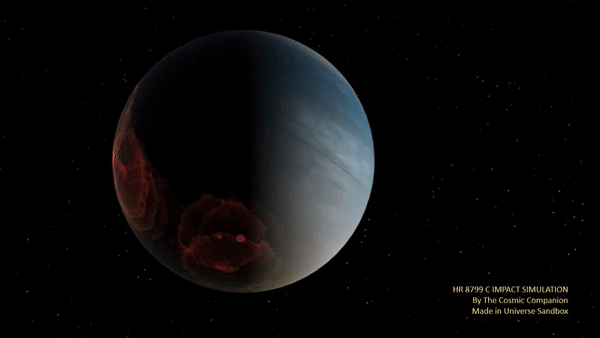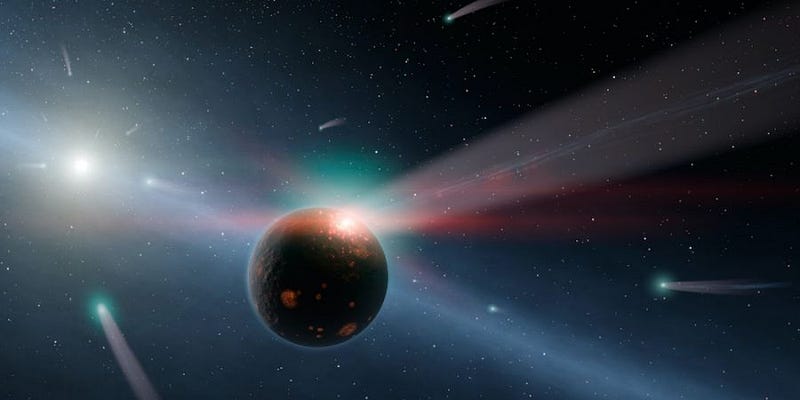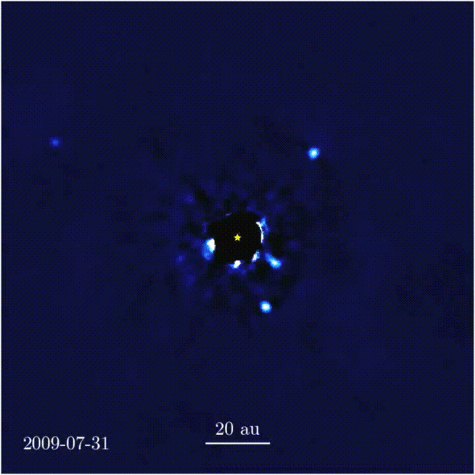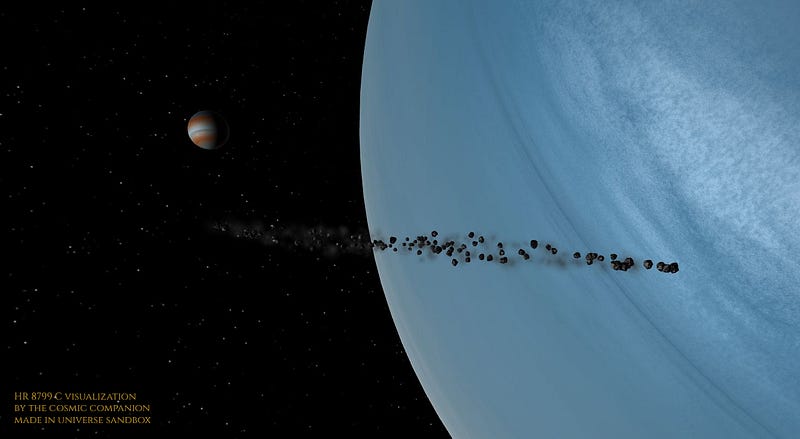# Exploring the HR 8799 Solar System: Asteroids and Comets
Written on
Chapter 1: The HR 8799 Solar System
The HR 8799 solar system bears a striking resemblance to our own, prompting researchers to explore the role of asteroids and comets in this distant star system. Similar to our solar family, HR 8799 hosts four massive planets, along with a possible array of smaller, rocky planets orbiting closer to the star.
This planetary system, located 129 light-years from Earth, features two asteroid belts flanking its four giant planets. While smaller, rocky planets may exist nearer to the star, current technology does not permit their detection.

Impacts visualized on the supermassive worlds of HR 8799 c. Image credit: The Cosmic Companion/Made in Universe Sandbox
Researchers from the University of Groningen and SRON Netherlands Institute for Space Research capitalized on this similarity to delve into the HR 8799 system. In our own solar system, the inner planets (Mercury, Venus, Earth, and Mars) are composed of rock, while the outer planets (Jupiter, Saturn, Uranus, and Neptune) are primarily gaseous and icy.

An exoplanet struck by comets. Image credit: NASA/JPL-Caltech
Many astronomers theorize that the arrangement of planets in our system was influenced by intense solar winds that pushed gas and dust outward, resulting in the inner planets losing their lighter materials. The Sun's heat also evaporated much of the ice on these inner worlds, complicating the retention of water. In the cooler outer regions of the Solar System, gas and water ice accumulated, giving rise to the giant planets.
Asteroid Belts and Their Formation
The central star of the HR 8799 system is approximately 1.5 times the mass of our Sun and nearly five times brighter, making it visible to the naked eye under dark skies. This planetary system is relatively young, with estimates placing its age around 30 million years.

The HR 8799 system, seen by the Keck Telescope. Image credit: Video making & motion interpolation: Jason Wang Data analysis: Christian Marois Orbit determination: Quinn Konopacky Data Taking: Bruce Macintosh, Travis Barman, Ben Zuckerman
To better understand this system, researchers conducted simulations to model the behavior of asteroids and comets. "The model comprises the host star, four giant planets (HR 8799 e, d, c, and b), 650,000 test particles representing the inner belt, and 1,450,000 test particles for the outer belt. Additionally, we modeled dust populations originating from both belts," the researchers explained in an article published in Astronomy and Astrophysics.
The simulation indicated that two asteroid belts would form within a million years of the planets’ creation. The outer asteroid belt was confirmed by the Spitzer Space Telescope, while the inner belt's existence was inferred from excess infrared radiation detected by the same observatory. The inner belt holds about one-millionth of Earth's mass and orbits at distances between six and 15 times that of the Earth to the Sun. The outer belt circles the star at distances ranging from three to ten times farther than the Sun to Neptune, the farthest planet in our solar system.
Gravitational Dynamics and Composition
The HR 8799 system is considerably larger than our solar system, with its giant planets surpassing the mass of any planets orbiting the Sun.

Fragments of rock and metals approach HR 8799 C, just prior to collision. Image credit: Visualization by The Cosmic Companion / Created in Universe Sandbox
As these planets orbit their star, gravitational interactions created gaps in the system, similar to the Kirkwood gaps in our own solar system caused by Jupiter's gravitational pull. Researchers also determined that smaller celestial bodies—asteroids, comets, and dust—likely influenced the chemical makeup of the exoplanets within the system.
These small bodies transported rocky materials and metals from the inner solar system to the outer planets while also moving icy materials from the outer solar system to those closer to the star. Over time, these materials accumulated, potentially representing up to half a millionth of the mass of these worlds, according to the researchers.

A look at what HR 8799 may look like. Image credit: The Cosmic Companion / Created in NASA’s Eyes
Further investigation is needed to quantify the amount of material transported by these small bodies within the system. Upcoming telescopes, including the James Webb Space Telescope (JWST), set to launch in 2021, will have the capability to measure concentrations of refractories (rocks and metals) in the outer planets, allowing for validation of the simulation's findings.
"If telescopes identify the expected quantity of refractories, it indicates that these can be accounted for by the delivery process from the belts as outlined in our model. Conversely, if more refractories are detected than anticipated, it suggests a more active delivery process than previously assumed," explains Kateryna Frantseva from the Kapteyn Astronomical Institute at the University of Groningen.
If asteroids and comets in this system deliver greater amounts of material than predicted, it could imply that the HR 8799 system is significantly younger than our solar system. A substantial influx of water to the inner regions of the system, coupled with the presence of Earth-like planets, might enhance the potential for life in this exoplanetary system.
James Maynard is the founder and publisher of The Cosmic Companion, residing in Tucson with his wife Nicole and their cat, Max.
Did you enjoy this article? Connect with us on The Cosmic Companion Network for our podcast, weekly video series, informative newsletter, news briefings on Amazon Alexa, and more!
Chapter 2: Comets and the Stardust Mission
The exploration of comets plays a crucial role in understanding the formation of our solar system and beyond. The Stardust mission, which successfully collected samples from the comet Wild 2, offers a glimpse into the primordial materials that formed our celestial bodies.
The first video titled "Comets and the Stardust Mission" discusses the significance of comets in the context of planetary formation and the insights gained from the Stardust mission.
Chapter 3: Planets Orbiting HR 8799
The HR 8799 system showcases a unique arrangement of exoplanets, offering a fascinating study of planetary atmospheres and compositions.
The second video titled "Planets Orbiting HR 8799" explores the characteristics and discoveries related to the planets within the HR 8799 system.